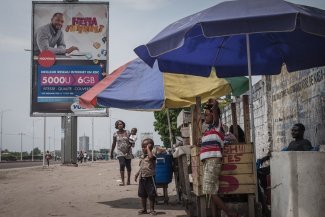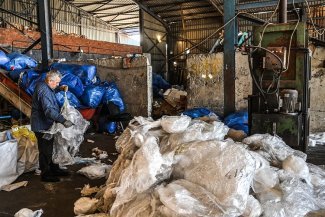About 220 kilometres south-west from the Zimbabwean capital city of Harare lies the town of Redcliffe. Once the beating heart of Zimbabwe’s steel industry, it is now little more than a ghost town.
When Equal Times arrived at 09.00 on a hot Wednesday morning in February, in previous years it would have been abuzz with activity as the nearby factory churned out tonnes of steel by the hour. Now, an eerie quiet prevades.
Men in overalls play checkers outside a closed shop. Elsewhere old buildings stand derelict, some with shattered window panes. They were once used as store rooms and lodgings for the Chinese contractors that are now as absent as the company’s profit.
The Zimbabwe Iron and Steel Company (ZISCO, formerly RISCO) was founded in what was then Southern Rhodesia in 1942. At its peak, Ziscosteel, as it is also known, was Africa’s largest integrated steel works. Wholly government owned, it produced up to one million tonnes annually and employed some 8,000 people.
Ziscosteel exported to Europe and Asia as well as neighbouring African countries before its demise in 2008, owing to the pressures of Zimbabwe’s shattered economy, gross mismanagement and corruption. When the government tried to sell the company in 2011, Ziscosteel’s debt had risen to approximately US$372 million.
Today, following years of wrangling and skeletal production, the steel works has been taken over by the India-based Essar Holdings, but the change in ownership has not yet made any difference to the life of the town’s remaining inhabitants.
Employees are still owed a staggering US$100 million in outstanding salaries. School fees and medical bills continue to go unpaid as families, struggling to survive after more than five years without either pay or pensions, can no longer afford them. According to the Ziscosteel workers’ committee, more than 200 former workers have died since 2011 because they have been unable to pay for medicine or hospital treatment.
Shops and subsidiary businesses have been forced to shut down, rubbish goes uncollected as residents are unable to pay their rates and water supplies are being cut off as a result of the massive debt owed by Redcliff’s inhabitants.
The men playing checkers are amongst the approximately 1,500 remaining workers sent home on six months’ unpaid leave in February 2016, sparking protests. The workers had continued to report for duty despite an announcement by Finance Minister Patrick Chinamasa that their contracts had been terminated on three months’ notice in December 2015.
The company had been giving the workers flat allowances of as little as US$50 since January 2015 but many workers received as little as US$100 for the whole year.
“Management only told us they are still looking for the money to pay us but we are not sure where they are trying to find the money because the company is not selling anything meaningful at the moment,” a workers’ committee representative said on condition of anonymity.
“Some workers’ children have not yet received their exam results because they owe huge amounts in unpaid school fees and levies,” he told Equal Times. “The schools are demanding payments or at least asking people to make payment plans, but it is impossible to come up with a payment plan when you don’t know when next you will get paid.”
The workers’ representative said the company was not communicating anything to them, even when they attend meetings in Harare.
“They don’t give us any feedback. We get to know most of the things through the newspapers. Nobody comes on the ground to explain to us what is going on. Even government is silent,” he said.
Another worker, who also asked to remain anonymous, who was sent on forced leave in February told Equal Times: “I don’t think there is any hope of us going back to work. I think this [the forced leave] was their way of doing away with us.
“The issue of payment has gone to arbitration and the employer agreed mutually that he owes us, but his capacity to pay is now questionable. We ourselves can also see that there is no production, the only people left at the company are there as security looking after equipment,” she said.
Billions lost
Once the biggest employer in the Midlands province, Ziscosteel used to make the towns of Redcliff and Torwood tick, with employees making up the bulk of customers for businesses in both municipalities.
The company’s woes have also had a major impact on Zimbabwe’s economy as a whole. According to the Zimbabwe Economic Policy Analysis and Research Unit (Zeparu), more than US$20 billion in potential revenue has been lost since Ziscosteel closed in 2008.
The country’s biggest metal union, the National Union of Metal and Allied Workers Union of Zimbabwe (NUMAIZ) has not been spared either, as it has lost thousands of paying members from Ziscosteel and its subordinate companies.
“We commanded more than two-thirds of the membership at Ziscosteel and they have not been paying subscriptions for the past five years, which has had serious implications on our cash flow as a union,” NUMAIZ General Secretary Henry Tarumbira told Equal Times.
His deputy, Stephen Dhliwayo, said the government was not serious about reviving Ziscosteel and was not sincere in its dealings with potential investors.
“The government must have shown some commitment to revive Ziscosteel because it is going to help in its ZimAsset programme,” he told Equal Times, referring to a 2013-2018 plan formally called the Zimbabwe Agenda for Sustainable Socio-Economic Transformation.
“There are parastatals and companies such as the National Railways of Zimbabwe and Hwange Colliery Company whose revival also depends on the survival of Ziscosteel,” he said.
Zimbabwe also has a huge market for steel as shown by the fact that many companies are currently importing the product from South Africa, Dhliwayo said.
But Zimbabwe’s steel crisis is not unique. The global steel industry is in decline due to oversupply and reduced demand, with the United Kingdom recently losing 5,000 jobs in the industry and some 9,000 jobs in peril in the United States.
However, the crisis is having a massive impact in South Africa where already 47,000 industry jobs were lost between 2012 and the first quarter of 2015, and a further 50,000 job cuts have been predicted by industry analysts.









